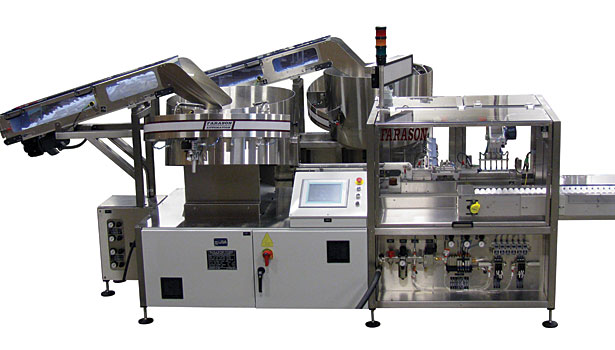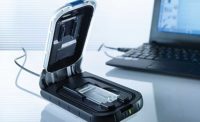Farason Corp. has been designing and building automated assembly systems for more than 25 years. Based in Coatesville, PA, the company has designed automation systems for food, cosmetics, medical devices, pharmaceutical products, personal care products, toys and solar cells. The company’s client list includes Blistex Inc., Crayola Crayons, L’Oreal USA, Smith Medical and even the U.S. Mint.
Recently, a medical device manufacturer contacted Farason to devise a system to assemble two cylindrical plastic parts. One part slides into the other, and the assembly snaps together. The manufacturer needed a production rate of 120 assemblies per minute.
Component A is a vial containing a near-aqueous solution. Measuring 0.375 inch in diameter and 1.5 inches long, the vial is fed with a slant disc sorter that singulates the parts, hangs them by their larger diameter end, and releases them into a C-shaped chute. The parts exit onto a conveyor traveling supine, end to end, uniformly oriented.
Component B is a tubular sleeve to contain the vial for transport in downstream equipment. Measuring 0.5 inch in diameter and 3.75 inches long, the sleeve is fed with a pocketed disc sorter that singulates the part into pockets located radially along the peripheral edge of a rotating plastic disc. The pockets are contoured to match the shape of the part. A Presence Plus camera from Banner Engineering Corp., mounted to the outside of the bowl, looks down on the parts as they pass below. The camera determines the orientation of the parts by identifying the presence or absence of castellation on one end. Incorrectly oriented components are ejected from their pockets by a blast of air before they can exit the bowl.
Also known as centrifugal feeders, disc sorters do not use vibration to singulate and orient parts. Instead, they rely on the principle of centrifugal force. Parts drop onto a rotating disc, and centrifugal force whisks them to the periphery of the circle.
A pocketed disc sorter is like a roulette wheel. Custom fixtures along the outer edge of the disc capture correctly oriented parts as they slide radially from the center of the disc. As with a vibratory feeder bowl, parts that are misaligned are blocked and recirculated. A slanted disc sorter works the same way, except that it also gets a helping hand from gravity, since the disc is tilted. Instead of remaining to the edge of the disc, the parts are funneled to a specific point, where they queue up at the feeder’s exit. There, custom tooling accepts correctly oriented parts and blocks misaligned ones.
These flexible feeders can accommodate a family of parts of similar shape and size simply by changing the fixtures. Fixtures can be swapped out without tools. Centrifugal feeders can provide higher feed rates than vibratory bowls, and they can often handle applications that vibratory bowls cannot, such as oily parts.
Component B exits the bottom of the sorter and enters a 90-degree vertical twister that reorients it so that it lies across a rubber-belted conveyor, perpendicular to the direction of travel. The components are fed around the end of the conveyor and into a vertical chute where a column is formed.
A walking beam assembly carriage removes Component B from the column and transfers it toward Component A. Traveling perpendicular to the assembly carriage, Component A enters the walking beam and travels parallel and adjacent to a corresponding Component B.
The walking beam provides controlled, accurate movement and positioning of the components. Assembly occurs downstream by means of a pneumatic pusher that extends, contacts Component A, and drives it into Component B. An overhead containment holds Component B in position during the assembly process.
To meet the production rate, Farason’s engineers had to ensure the outside diameter of the vial and the inside diameter of the sleeve were aligned to a tight tolerance. The difference between a correctly seated vial and a reject was just 0.03 inch, says Darren Max, applications engineer and project manager at Farason. High-speed inspection and accurate positioning were critical aspects of the system.
A laser gauging sensor from Banner verifies that the components have been assembled to a precise overall length. A two-axis Cartesian robot, equipped with a six-up vacuum end-effector, removes the assemblies from the walking beam and transfers them into fixtures on the in-feed conveyor of an Accraply labeler. Assemblies deemed as rejects are not removed from the walking beam and exit off the end into a collection receptacle.
For more information on automated assembly systems, visit www.farason.com or call 610-383-6224.
For more information on sensors and vision systems, visit www.bannerengineering.com or call 763-544-3164.
For more information on labeling systems, visit www.accraply.com or call 800-328-3997.
Editor’s note: Whether you’re a systems integrator or the in-house automation team of an OEM, if you’ve designed a system that you’re particularly proud of, tell us about it. Send an e-mail to John Sprovieri, editor of ASSEMBLY, at sprovierij@bnpmedia.com, or call 630-694-4012.

